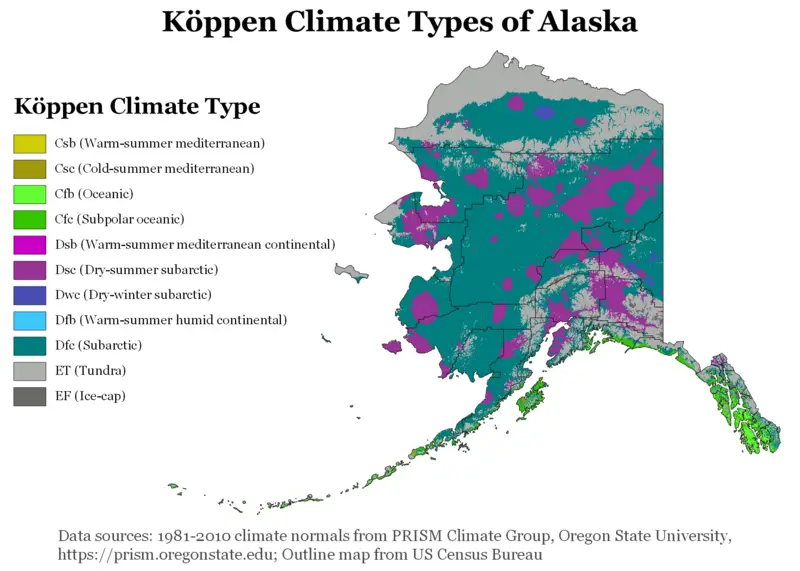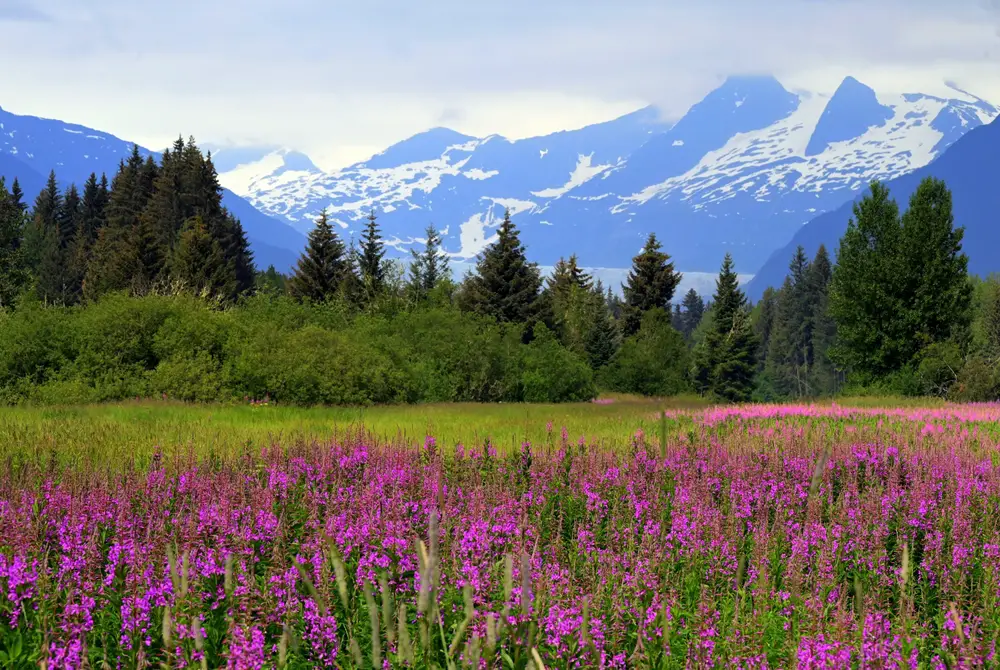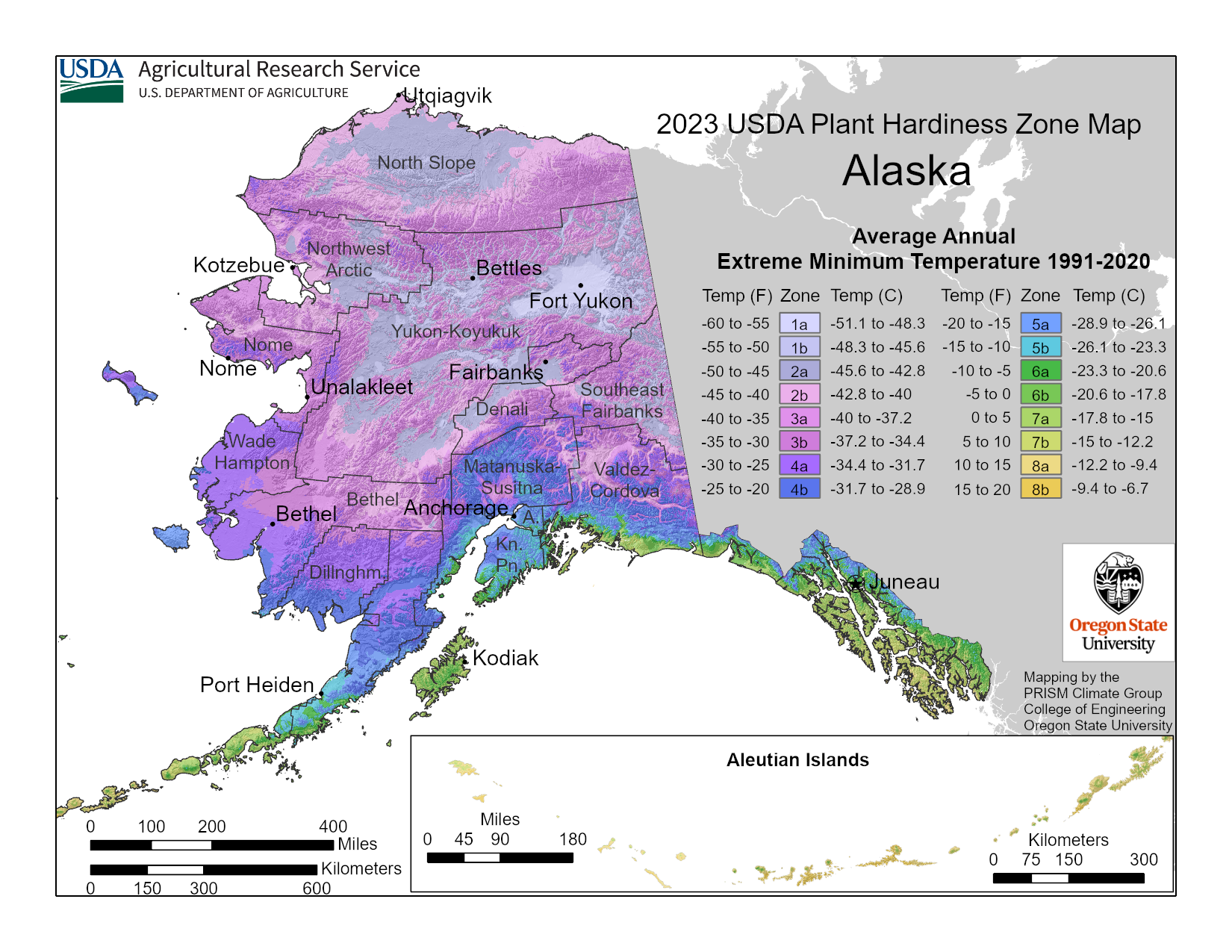Alaska Plant Hardiness Zones
| USDA Hardiness Zone | Average Minimum Extreme Winter Temperature Range Fahrenheit (°F) Celsius (°C) | Average Last Frost Date Range In Spring (Beginning Of The Growing Season) | Average First Frost Date Range In Autumn (End Of The Growing Season) |
|---|---|---|---|
| 1a | -60°F to -55°F -51.1°C to -48.3°C | Year-round risk of frost | Year-round risk of frost |
| 1b | -55°F to -50°F -48.3°C to -45.6°C | Year-round risk of frost | Year-round risk of frost |
| 2a | -50°F to -45°F -45.6°C to -42.8°C | Year-round risk of frost | Year-round risk of frost |
| 2b | -45°F to -40°F -42.8°C to -40°C | Year-round risk of frost | Year-round risk of frost |
| 3a | -40°F to -35°F -40°C to -37.2°C | Late May | Late August |
| 3b | -35°F to -30°F -37.2°C to -34.4°C | Late May | Late August |
| 4a | -30°F to -25°F -34.4°C to -31.7°C | Mid to late May | Early September |
| 4b | -25°F to -20°F -31.7°C to -28.9°C | Mid to late May | Early September |
| 5a | -20°F to -15°F -28.9°C to -26.1°C | Mid to late May | Mid-September |
| 5b | -15°F to -10°F -26.1°C to -23.3°C | Mid to late May | Mid-September |
| 6a | -10°F to -5°F -23.3°C to -20.6°C | Early May | Late September |
| 6b | -5°F to 0°F -20.6°C to -17.8°C | Early May | Late September |
| 7a | 0°F to 5°F -17.8°C to -15°C | Early May | Early October |
| 7b | 5°F to 10°F -15°C to -12.2°C | Early May | Early October |
| 8a | 10°F to 15°F -12.2°C to -9.4°C | Early May | Early to mid-October |
| 8b | 15°F to 20°F -9.4°C to -6.7°C | Early May | Early to mid-October |
Alaska Growing Conditions

Credit to Wikipedia
General Climate
Alaska’s climate varies in every sense of the word. Though many think of Alaska as arctic, only the northern third of it is.
Arctic, or polar, climates have or are:
- Severe winter weather, well below freezing
- Cool summers
- Treeless tundra
- Very short winter days, very long summer days
- Near the poles geographically
The rest of Alaska is in the northern part of the temperate zone. This means much of Alaska has a subarctic continental climate, which has or is:
- Warm to cool and short summers
- Cold, long winters
- Extreme temperature fluctuations between seasons
- 5-7 consecutive months when the average temperature is below freezing
- On an inland location
Pacific Ocean currents warm Southern coastal Alaska. It has a mid-latitude oceanic climate that features:
- Cool summers
- Mild winters for their latitude
- Less extreme temperature variation between seasons
The Bering Sea moderates the northwest coast. It has a subarctic oceanic climate, which is rather moderate for how far north it is.
Microclimates
USDA plant hardiness zones are an important starting point for your garden, but you’ll also need to consider microclimates.
Microclimates are areas where specific conditions create a climate different from the climate they’re situated in.
Buildings, fences, paved areas, or short hills and valleys can create these microclimates.
They can be as small as a space in your backyard or as large as a city.
In other words, learn about your local conditions from local experts to see if your garden falls into a microclimate.
Extreme Weather
Williwaws
Williwaws are like Chinooks in that they are location-specific and a powerful enough wind to warrant their own name. They exist around the world by coastal mountains. The term “williwaw” is used in Alaska and British Columbia, though its origin is unknown.
Williwaws are cold and dense air masses that begin at high mountain elevations. They pick up speed as they begin to sink down the sides of those mountains. By the time they hit the ground, they are moving so quickly that they are instantly violent winds, typically propelled out to sea.
In Alaska, they affect coastal and island regions. To protect your garden from winds, stake any plants that need support and consider incorporating windbreaks into your garden design.
Blizzards
Blizzards have a few key characteristics:
- Strong winds and snowfall
- Freezing temperatures
- They last several hours
- They limit visibility
- And they can leave behind lots of snow
All these elements risk damaging your plants, potentially resulting in “winter kill” (exactly what it sounds like). To help prevent this, choose plant varieties that can withstand cold temperatures.
Take the following steps to further prepare those plants for winter:
- Wrap them in burlap
- Water deeply
- Cover roots with a layer of straw or wood chip mulch
You don’t have to do all of these, but each is helpful (and you should do them before temperatures drop below freezing).
Ex-Typhoon and Coastal Storms
A typhoon is the same weather phenomenon as a hurricane but is called a typhoon because of its location: over the Northwest Pacific Ocean.
Typhoons form where water is warm. Adjacent warm air absorbs moisture from the ocean. When it meets cold air, it rises through it and creates a spiraling storm.
Most typhoons that form in warmer climates become ex-typhoons by the time they reach Alaska.
These storms crash into Western Alaska coastal communities, flooding and eroding land, sometimes several miles inland.
As global temperatures increase, the sea ice that has long shielded these communities from these kinds of storms is melting, and the severity of the events and consequences is increasing.
Unfortunately, beyond general emergency preparedness around your property, there is little to do to protect your garden.
If such a storm does affect your home and garden, pruning away affected portions of plants may help them recover.
Thunderstorms
Since warm, unstable air fuels thunderstorms, Alaska’s thunderstorm season is quite short, typically limited to June and July. They are also somewhat unusual.
Thunderstorms bring with them several different and potentially threatening phenomena, including wind, lightning, extreme precipitation, which can potentially cause wind damage, forest fires, and flooding. As temperatures rise globally, so does the occurrence of thunderstorms in Alaska.
Staking necessary plants and incorporating good drainage in any garden design may help your garden weather the storm.
Growing Season
Does Alaska have four seasons? It does! June, July, August, and Winter!
No doubt, the growing season in Alaska is short. Depending on location and the weather conditions that year, it averages around 105 frost-free days.
That said, the light conditions are different than in most other places as well.
From the end of April until mid-August, daylight extends and peaks at 24 hours at the summer solstice. So, the plants can grow almost double time!
Alaska Gardening Tips

Choose The Right Plants
Growing in Alaska is like few other places. There can be significant variations in temperature from region to region and even year to year.
One problem you will face is likely not having significant prolonged heat. So, in addition to choosing locally adapted seeds and plants, choose varieties that prefer cooler temperatures and are early to mature.
Extending Your Growing Season
If you want to grow plants that take longer than your regular growing season outdoors, you will want to start seeds indoors or purchase seedlings that you can plant in your garden once the weather warms enough.
Some people use hoop houses or greenhouses to ensure their season is long enough.
Gardening And Wildlife
With fewer people and lots of land to sustain all kinds of life, Alaska has no shortage of animals.
If your garden isn’t fenced, wildlife may come into it. Even if you do, the temptation may draw foxes, deer, rabbits, moose and even bears.
Fencing is a step you can take. Some people even use electric fencing depending on your location and what you are growing.
Choosing to locate your garden in open spaces and keeping it clear of anything that may attract bears (don’t compost your food here) will also help deter them.
If you are planting deciduous trees, protect their trunks with chicken wire and install a makeshift fence with wire fencing, steel supports, and zip ties.
Consult With Local Professionals
Consulting with local gardening professionals allows you to benefit from their experience with your area’s conditions, the plants that do well there, and overall best practices.
Alaska Plant Suggestions

Trees
- Sitka Spruce (Picea sitchensis)
- Larch (Larix laricina)
- Paper Birch (Betula neoalaskana)
Shrubs
- Wild Rose (Rosa acicularis)
- Red-Osier Dogwood (Cornus stolonifera)
- Juniper (Juniperus communis)
Flowers
- Heart Leaved Arnica (Arnica cordifolia)
- Fireweed (Chamerion angustifolium)
- Yarrow (Achillea millefolium)
Vegetables
- Sheep Sorrel (Rumex acetosella)
- Wild Onion (Allium schoenoprasum)
- Potatoes (Solanum tuberosum)
Herbs
- Plantain (Plantago major)
- Dandelion (Taraxacum officinale)
- Red Clover (Trifolium pratense)
Spices
- Juniper berries (Juniperus communis)
- Wild mint (Mentha arvensis)
- Bull Kelp (Nereocystis luetkeana) 9
Fruits
- Cloudberry (Rubus chamaemorus)
- Saskatoon berry (Amelanchier alnifolia)
- Lowbush Cranberry (Vaccinium vitis-idaea)
Succulents
- Roseroot (Rhodiola integrifolia)
- Russian Stonecrop (Sedum kamtschaticum)
- Autumn Joy Sedum (Sedum spectabile ‘Autumn Joy’)
Disclaimer
Any of the above can change and is not exhaustive.
Treat anything above like a good starter guide. Then use that as a foundation as you consult with local gardeners, professionals, forecasts, guides, and organizations.

